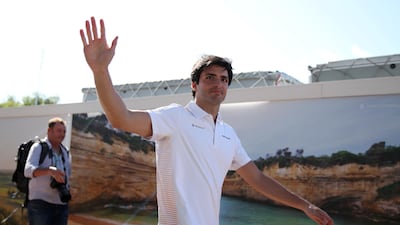Ferrari's decision to sign little known Spaniard Carlos Sainz for 2021 is nothing short of mystifying.
Even after five years in Formula One the name is more synonymous with his father, a buccaneering double rally champion who retired 15 years ago.
And while Maranello will celebrate the youngest line-up in their history, the Gestione Sportiva has never, traditionally, been about investing in tomorrow.
There is an impatient and passionate Italian nation hanging over their shoulder and sponsors paying top dollar for success.
In the past, Ferrari have been accused of having more money than sense, but they could afford to be that way. They let other teams deal in potential. They usually flashed the cash once a soaring reputation was established.
Fernando Alonso, Michael Schumacher, and Sebastian Vettel were all champions before the boys in red came knocking.
In fact, you have to go back to 1995 for the last time Maranello didn't have a champion in their line-up. And for five years straight, up to last year, they only had champions at the wheel.
So why the dramatic change in approach that sees them turning to a duo with a handful of wins between them? Ferrari have rarely taken risks on potential as heavily as they are in 2021.
Charles Leclerc may have been just one season in to his F1 career when they snapped him up, but that was a near guarantee. Plus, they already had a four-time champion in the other car.
In signing Sainz they not only ushered the second-biggest name in F1 out the door but passed on Alonso and Daniel Ricciardo as well.
Alonso would surely bring trouble, but so what? Riccardo can beat the best and he is of Italian descent. Better than perfect, surely?
Of course, neither would have come cheap. Alonso at $45 million (Dh165.3m) and Ricciardo south of his current, humble, $29.6m Renault stipend. By comparison Sainz will only cost a few million.
Maybe Ferrari don’t want a Lewis Hamilton? They want a Valtteri Bottas: a No 2 faithfully following team orders. An Eddie Irvine or Rubens Barrichello: quick enough to see them to the constructors' championship but not fast enough to disturb Leclerc’s mojo.
Risking it with Sainz then means relying on Leclerc, in only his fourth season in F1, to be Ferrari’s standard bearer. That is a lot of pressure on a young racer. Cruising to victory in Vettel’s shadow is very different from shouldering the hopes of a team and nation yourself.
It’s interesting to pause here and reflect on the man making the decisions: new Ferrarai boss Mattia Binotto. Apparently pulled out of nowhere last year he has, in fact, been in key roles since the 1990s. Politically adept and culturally savvy he doesn’t appear the kind to risk his career recklessly on an also-ran.
He may be part of the furniture at Maranello, but he will be aware it would only take a few wrong decisions and he would be out of the door.
_____________________
Rated: the F1 2020 drivers' lineup
_____________________
Perhaps the apparent lack of ambition reflects their reservations about the competitiveness of this year’s car, which will be used in 2021 too. The results from pre-season testing were beyond alarming for a team of their calibre.
Then there are Sainz’s stark career stats. He has shown clear speed but never set the world alight. Promised the world and delivered an atlas. He was begrudgingly recruited by Red Bull, never key in their thinking and bounced through Toro Rosso and Renault to McLaren without really tearing up any trees.
In his best season just passed, his fifth in F1, he wasn’t clearly better than 19-year-old rookie Lando Norris. But the sterling Brazil drive from last to a fourth that eventually became his first podium summed his career up. It was good but ...
Surely the straw Maranello is clutching at doesn’t come from the fact that Sainz ran a rookie 17-year-old Max Verstappen mighty close in their first year in F1?
Of course, there is another intriguing possibility. With the coronavirus pushing back the dawn of an exciting new F1 era to 2022, Sainz could be the stop-gap option, easily disposable for a marque signing already committed from 2022: namely Lewis Hamilton or Max Verstappen.
By then record-breaker Hamilton will probably have nothing left to prove with Mercedes or, more likely, Verstappen will be ready for a long, eye-watering deal in red.
Now that really does make sense.





















